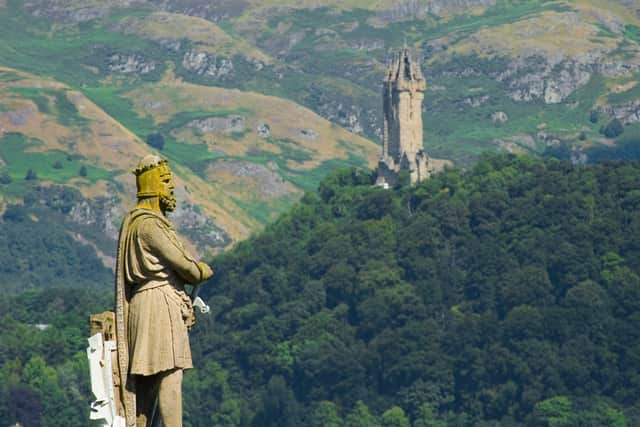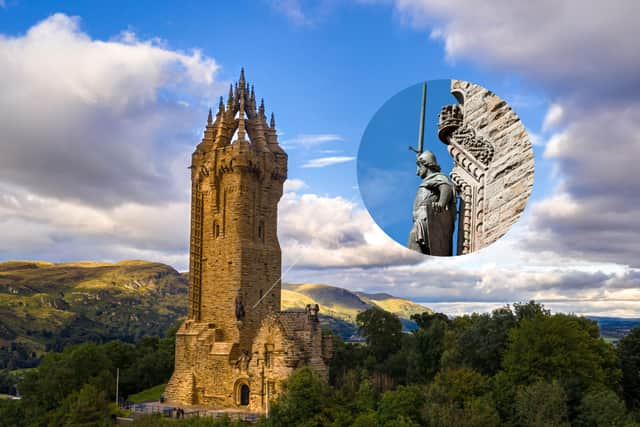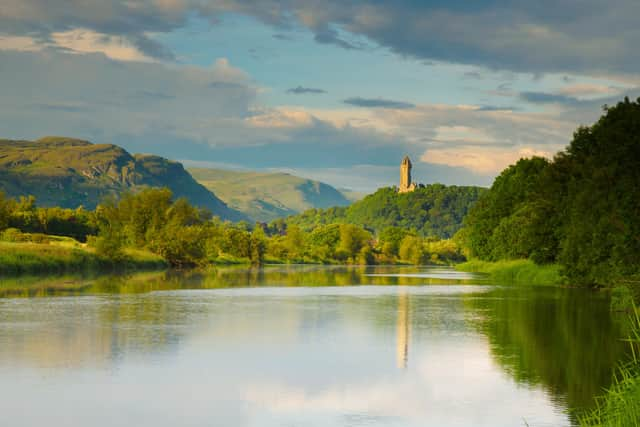Wallace Monument 154th Anniversary: History and origins of the iconic Scottish landmark


From the verdant Ochil Hills to historical landmarks like the castle and Wallace Monument, Stirling’s skyline is not only breathtaking but also rich in Scottish history.
At the esplanade of Stirling Castle we find a statue in honour of Robert the Bruce, another Scottish war hero, and this is positioned perfectly such that the monument - with its own statue built for William Wallace - is well-placed in the background as though the two men were respectfully nodding to one another.
Advertisement
Hide AdAdvertisement
Hide AdKnown officially as the National Wallace Monument, this striking landmark is easily one of the city’s most-visited locations and it commemorates the life of the Scots martyr, Sir William Wallace, who would become Scotland’s National Hero.
The building stands above the fields where Wallace commanded his troops to victory against the English at the famous Battle of Stirling Bridge. In 2019, the monument celebrated its 150th anniversary and that date is today (September 11) which now marks the 154th year since it opened its doors for the first time.
The Scottish war hero may have died over seven centuries ago but his story and what it means to Scots lives on in the hearts of many.
Here is an overview of the National Wallace Monument including its history and origins, a visitor guide and a run-through of how William Wallace rose to prominence in Scotland.


What is the National Wallace Monument?
The National Wallace Monument is a famous 19th-century monument built in honour of William Wallace. According to Hidden Scotland: “It commemorates how Wallace won the Battle of Stirling Bridge against King Edward’s army.”
Architecturally, it is described as a ‘large tower with a winding staircase’ and, within many levels of the building, visitors are treated to a variety of attractions.
Ground Level: Keeper’s Lodge and a gift shop.
First Level: an exhibition that explains William Wallace and his life story.
Second Level: the ‘Hall of Heroes’ that showcases dozens of important historical figures in Scotland.
Advertisement
Hide AdAdvertisement
Hide AdThird Level: information about the Battle of Stirling Bridge and the weapons employed for it.
Top Level: “the Crown” - from here visitors enjoy a panoramic view that covers the Ochil Hills, Pentland Hills, the Trossachs and Ben Lomond.
History of the Wallace Monument
Five centuries after the Battle of Stirling Bridge there was a movement that sought to build a monument in Wallace’s honour. The campaign is widely credited to Rev. Charles Rogers who, despite being known as a ‘disagreeable’ sort who often attracted trouble, was able to encourage others to support a monument design competition and fundraising in 1856.
True to Glasgow’s legacy of being home to gifted architects (e.g., Charles Rennie Mackintosh) the competition was won by a Glaswegian man named John Thomas Rochead. The Stirling Local History Society reports:
“Unlike other national monuments, the monument was funded by contributions from the public rather than by government, and partly for this reason fundraising was difficult to the extent that on more than one occasion it was questionable whether the monument might ever be completed.
“After intermittent and not altogether straight forward fundraising, the foundation stone was laid on the 24th of June 1861 by the Duke of Atholl to wide public enthusiasm.
“When the monument was finally inaugurated in 1869 after eight years of building work, it was wildly over budget (almost double the original estimate) and had taken much longer than planned.”


Who was William Wallace?
According to Britannica: “Sir William Wallace (is) one of Scotland’s greatest national heroes and the chief inspiration for Scottish resistance to the English king Edward I.
Advertisement
Hide AdAdvertisement
Hide Ad“He served as guardian of the kingdom of Scotland during the first years of the long and ultimately successful struggle to free his country from English rule.”
Wallace is most famous for defeating the English army at the Battle of Stirling Bridge in 1297. He was appointed as a Guardian of Scotland and fulfilled this role until he was defeated at the Battle of Falkirk the following year.
Unfortunately, Wallace was later betrayed by a Scottish nobleman known as John Menteith in 1305 (who is sometimes associated with Scotland’s only natural lake; the Lake of Menteith) which saw him sentenced to death in London.
There, in England’s capital, the Scottish patriot was hung, drawn and quartered - one of the most brutal punishments of the medieval era.


How to get to the Wallace Monument
If you are arriving in Stirling via train then, as The National Wallace Monument website writes: “It takes just under 1 hour to walk from Stirling Railway Station.”
By car it would only take approximately ten minutes to arrive and there are bus and taxi options available. The National Wallace Monument has a car park, when you arrive there you have two options as to how to get up to the monument on top of Abbey Craig.
Firstly, a small shuttle bus operates or - as most people opt for - you can simply walk up the hill.
Comments
Want to join the conversation? Please or to comment on this article.
